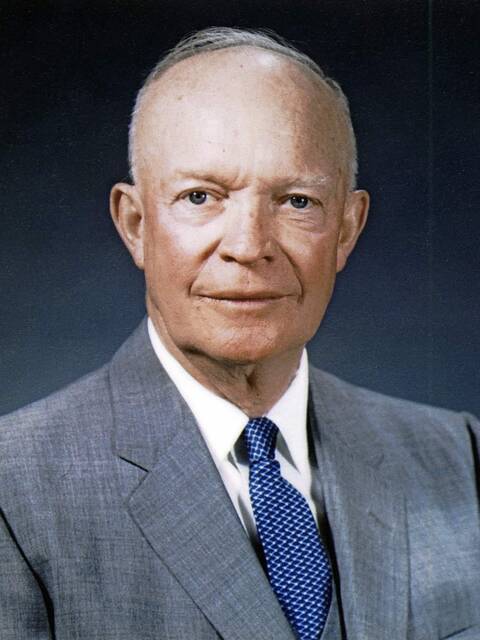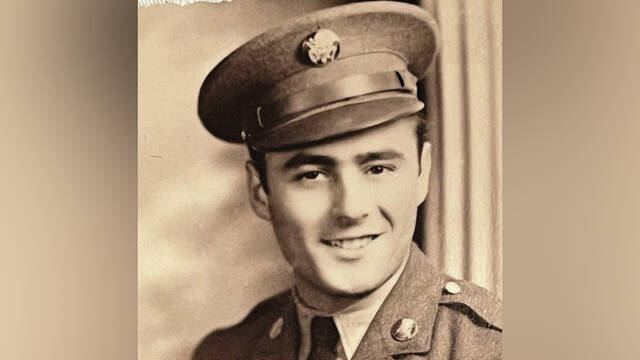One of the catchiest campaign slogans in American history is “I like Ike.”
It turned out to be effective, too: Dwight D. Eisenhower was elected president twice, both times by relative landslide.
And the statement apparently reflects Eisenhower’s personality to a tee.
“He was a genuine, authentic person,” historian Dick Jewell said. “He was kind. He listened. He was a very good listener. He didn’t put on airs. He was simply a down-to-earth fellow.”
Jewell gave a presentation about the 34th U.S. president as part of the Bethel Park Historical Society’s lecture series, returning to the podium following his well-received November program for the 60th anniversary of John F. Kennedy’s assassination.
“I’m going to call him ‘Ike.’ He preferred ‘Ike,’” Jewell said as he delved into the future World War II hero’s childhood in Abilene, Kan., through his time as a West Point cadet and ascendant Army career.
For those who are enamored of such details, Ike was born Oct. 14, 1890, Denison, Texas, and his family moved to Abilene a few years later. He is quoted as crediting the town with instilling a “standard of values that placed a premium upon integrity, decency, consideration for others.”
He and a childhood friend, Edward “Swede” Hazlett, decided to seek higher education at one of the U.S. military academies.
“Hazlett qualifies for the Naval Academy in Annapolis. Ike missed it by one point,” Jewell, an attorney who lives in Bethel Park, said. “One more point and he probably would have gone to the Navy with Hazlett, his buddy.”
Instead, Eisenhower headed for the Army and West Point, where he had his first brush with fame. The nearby New York Times referred to him as “one of the most promising backs in Eastern football” — at the time, by the most dominant region in the collegiate sport — and he helped the Cadets start the 1912 season with a 3-1 record before they lost decisively to the Carlisle Indian Industrial School, led by Jim Thorpe.
The following week, Army beat Tufts University. During the game, Ike suffered an injury that ended his career on the field, but not his involvement with football.
“They made him the freshman coach,” Jewell said. “He was a great mentor,” using innate skills such “relating to people, understanding what the mission was, understanding what kind of teaching methods were necessary.”
Rise through the ranks
He graduated in the upper half of West Point’s Class of 1915, after which he was assigned to Fort Sam Houston in San Antonio, Texas, where he met a woman named Mamie Doud.
“Within nine months, they were married,” Jewell reported, and the union lasted until Ike’s death on March 28, 1969.
His rise through Army ranks was aided by the mentorship of Maj. Gen. Fox Conner, who served as operations officer for the American Expeditionary Forces during World War I.
Conner nominated Eisenhower for Command and General Staff School at Fort Leavenworth, Kan., where he graduated No. 1 in his class in 1926. Three years later, he topped his class at the Army War College in Carlisle.
He spent the latter half of the 1930s serving in the Philippines under Gen. Douglas MacArthur, returning to the United States for an assignment at Fort Lewis, near Tacoma, Wash. In the aftermath of Japan bombing Pearl Harbor on Dec. 7, 1941, Army chief of staff and Uniontown native George Marshall summoned Ike to Washington, D.C.
“I need people who will make decisions, who will do command kinds of things, without bothering me,” Jewell quoted Marshall as telling Eisenhower. “Tell me anytime you want afterwards. My trust is in you.”
Eisenhower went on to plan and supervise Operation Torch, taking Allied forces into North Africa and then up through Italy in 1942-43, and Operation Overlord, the D-Day invasion of Normandy on June 6, 1944.
“He was not a warrior, per se. He was an expert on logistics,” Jewell explained: “How to move armies, how to feed armies, how to prepare them and try to get them ready and supply them, and keep them on their feet.”
When the Germans launched their final World War II offensive, the Battle of the Bulge in December 1944, Eisenhower was quick to counter by deploying 250,000 troops. And by the time the Allies triumphed over the Axis the following year, according to Jewell:
“Eisenhower now is the most famous person in the world.”
On to the presidencies
A logical next step, as Ulysses S. Grant took after the Civil War, was for Ike to seek the presidency. Actually, Harry Truman offered to step aside and run as vice president with Eisenhower on the 1948 Democratic ticket.
But Ike declined because he thought New York Gov. Thomas Dewey, a Republican, was going to emerge victorious.
“And if Dewey would have won, he was probably going to be there for two terms,” Jewell said. “And if he’s there for two terms, Eisenhower is going to be 66 — way too old to be president!”
Ike did become president, though: of Columbia University in New York City. His role turned out to be largely of a figurehead.
“When he took the Columbia job, he said, ‘I don’t want to be raising money. I don’t want to do an enormous amount of entertaining. I don’t want to oversee academic details.’ Now, as an old college president” — Jewell served in that capacity at Grove City College from 2003 to 2014 — “that’s my job description. I don’t know how he avoided all that.”
By 1952, Eisenhower had changed his mind about the American presidency, and with Richard Nixon as his running mate, won the November election handily over Illinois Gov. Adlai Stevenson. The Democrats ran Stevenson again four years, and he lost to Eisenhower by an even wider margin.
When Ike left office on Jan. 20, 1961, at age 70, he was the oldest person to have held the nation’s highest position.
“Times have changed, right?” Jewell observed.
C-SPAN surveys of presidential historians in 2017 and 2021 had Eisenhower ranked No. 5, with particularly high marks in administrative skills and moral authority.
“In his eight years, we had no war. We had essentially no inflation, and we had people who were relatively very prosperous,” Jewell said, plus Ike oversaw the implementation of “the interstate highway system, which was the greatest undertaking of building of roads, by far, in the history of this country.”
“That’s Mr. Eisenhower.”













